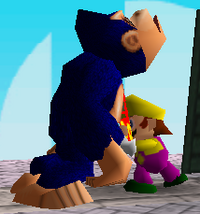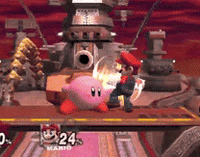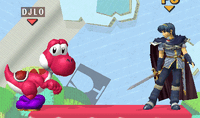Grab
A grab is the action of grabbing and holding an opponent. Regular grabs are performed by pressing R or Z+A (N64 Controller), Z, R+A, or L+A (GameCube or Classic Controllers), the - button (Wii Remote without Nunchuk) A+B (Wii Remote, with or without nunchuk), or Z+A, D-Pad down+A, or D-Pad left (Wii Remote+Nunchuk). Once grabbed, a character can be pummeled with the attack or grab buttons (Melee and Brawl only; Smash 64 has no pummel function.) and thrown by tilting the stick in one of the four standard directions (only two directions in Smash 64: Forward and Backward). A grabbed character will automatically escape after a certain amount of time depending on their damage; characters at higher damage percentages will be held longer (Smash 64 has no grab release excluding Donkey Kong's forward throw, which must be manually imposed by the opponent). Damage inflicted upon the grabbed character will increase grab time, and any button input by the grabbed character will decrease grab time.
Once a throw is begun, the character cannot escape, with the exception of Kirby's forward and back throws in Super Smash Bros. Melee. All throws grant eight invincibility frames to the thrower when started.
Grabs cannot be shielded; attempting to do so has no effect. This also means that grabs cannot be perfect shielded. Grabs ignore launch resistance as well.
In Melee and Brawl, characters can also grab while dashing, without cancelling the dash during the grab frames: this is called a dash grab. Every character uses an unique animation for dash grabs. Most dash grabs have further reach and more ending lag than regular ones, depending on the character, though some characters with extended grabs have different properties. For example, Link's dash grab seems to cancel the dash, giving him a very little boost forward, while Samus's is quicker than her normal grab, but has half its usual reach. Dash grabs were not present in Smash 64; instead, the dashing character grabs as usual, negating some momentum of the dash (depending on the character's traction). In Melee, grabs can also cancel jumps if the character hasn't left the ground yet, so that a normal grab can still be used after a dash. When dash-grabbing an enemy, while momentum is completely negated in Melee, in Brawl, when using a fast dash grab like Meta Knight's, both the grabber and the victim get some momentum forward after the grab.
Interrupting grabs in Super Smash Bros. causes the character that performed the grab to make his or her hard-damage noise. In Super Smash Bros. Melee, if a character grabbing another character is interrupted (that is, hit by an attack), the grabbed character will be sent flying horizontally.
A particular character can grab only one opponent at once, and similarly, a grabbed character cannot be grabbed by another one before being thrown or released. That means, when grabbing with the Ice Climbers, after one of them grabs the opponent, the other must instead use regular attacks on them. However, with good timing, he/she can still grab the enemy instantly after the other Ice Climber releases the enemy. Additionally, a pair of Ice Climbers can grab two respective enemies at once. In Melee, if the trailing Ice Climber grabs an opponent, he/she will be CPU-controlled. In Brawl, however, he/she is controlled by the player, allowing to throw the enemy freely and instantly grabbing them with the other Ice Climber afterwards, which allows for zero-to-death combos.
In Brawl, it is not possible to grab an opponent that is standing behind the grabber, even if the grab makes contact with a part of the target's body that extends in front of them. In the previous two games grabs will connect regardless of the opponent's position.
Special attacks as grabs
Some special attacks are technically grabs. When viewed with Melee's hitboxes, these attacks have the same green hitbox as standard grabs.
- Bowser's Koopa Klaw (can grab in the air or at close range on the ground, can only throw forwards or backwards. No invincibility frames)
- Bowser's Flying Slam (can grab and sacrificial KO opponents)
- Yoshi's Egg Lay (traps opponent in an egg, opponent takes half damage until they escape)
- Kirby and King Dedede's Inhale (traps opponent in Kirby or Dedede, opponent can wriggle to affect movement. King Dedede's is noticeably more powerful.)
- Captain Falcon's and Ganondorf's up special moves (grabs opponent in air and propels them away, can be done repeatedly if it connects the first time)
- Ganondorf's Flame Choke in Brawl (grabs opponent and slams them into the ground)
- Wario's Chomp (bites opponent several times, then spits them out).
- Lucario's Force Palm (grabs and throws forwards after about a second, cannot grab in air or at long range)
- Diddy Kong's Monkey Flip (latches onto an opponent, can either attack or jump into the enemy to release or let go)
- Mewtwo's Confusion at close range (grabs the opponent, spins them around, and drops them)
- Robin's Nosferatu (traps opponents and damages them while healing Robin)
If a character fails at grabbing a foe, he/she will suffer a considerable amount of lag, with most characters getting approximately 25 frames of lag. The lag can also be longer if a dash grab or pivot grab is used, except for characters with extended grabs. In Super Smash Bros., though, grabs can be used consecutively and more quickly, with all characters (except Link, Samus and Yoshi, who suffer as much lag as in the sequels) being able to execute a maximum of 4 grabs per second. In Melee, the Butterfingers bonus substracts 500 points to the player if he/she fails most of the grabs used, and the All Thumbs bonus substracts 1500 if 4 or more dash grabs were done without grabbing enemies. Additionally, the Cuddly Bear bonus awards 2000 points if the player grabs opponents 3 or more times without pummeling or throwing.
Tether grabs
Some grabs also have a significantly large reach, and can function as a recovery technique when used in midair (except in Smash 64). By pressing the grab button in midair, certain characters will extend a long-range grappling item, known as grab aerials. When used on the ground, these grabs have the longest range, but they have a lot of ending lag if the grab does not connect (lasting more than 60 frames). In Melee, if the grab connects with a wall, the character will hang from that wall and can press a button to be pulled up to where the end of the grab connected, allowing for second and third jumps to recover (known as wall-grapple). In Brawl, they will be shot to the nearest edge, making them tether recoveries. These include:
- Link, Toon Link and Young Link's Hookshot (and Link's Clawshot in Brawl)
- Samus' Grapple Beam
- Lucas's Rope Snake
In addition, there are several other ranged grabs, although they cannot be used as tether recoveries:
- Yoshi's tongue (the only character with a ranged grab without a tether recovery)
- Olimar's Pikmin, which dash forward and do the grabbing and throwing for him (one special is already a tether recovery)
- Zero Suit Samus's Plasma Whip (two of her specials are already tether recoveries)
- Ivysaur's vines (also one special is already a tether recovery)
- Villager's Net
- Pac-Man's tractor beam from Galaga.
Pivot grabs
A pivot grab is performed by dashing in a direction, then pushing the control stick in the opposite direction while inputting a grab. This results in the character pivoting and performing a grab with longer reach than a character's standing grab, and may be useful in varying one's approach. The animation for pivot grabs is also slightly different.
Initial grab range in Melee
Melee grab ranges by character according to Mew2King's webpage.
- Samus
- Link
- Young Link
- Marth
- Roy
- Yoshi
- Kirby
- Sheik
- Zelda
- Falco
- Jigglypuff
- Mewtwo
- Peach
- Fox
- Luigi
- Donkey Kong
- Ice Climbers
- Mr. Game & Watch
- Ganondorf
- Captain Falcon
- Mario / Dr. Mario
- Bowser
- Pichu
- Ness
- Pikachu
Initial grab range in Brawl
Initial grab range in Brawl.
Tether grabs (Grabs disjointed from the character)
1. Olimar's Blue Pikmin 10.1
2. Olimar's White Pikmin 10.0
3. Zero Suit Samus, Olimar's Red Pikmin 9.75
5. Olimar's Yellow Pikmin 9.6
6. Samus: 9.2-9.4
7. Link: 8.25
8. Olimar's Purple Pikmin: 7.5
9. Lucas: 7.25
10. Toon Link: 7
11. Yoshi: 6.75
12. Ivysaur: 6.1
Non-tether grabs
- Note: None of these characters' grabs are longer than the tether-grabbers although King Dedede's is very close to surpassing Ivysaur's.
13. King Dedede: 6
14. Charizard: 5.5
15. Zelda: 5.3
16. Donkey Kong: 5.1
17. Squirtle: 5
18. Marth, Diddy Kong , Snake: 4.75
21. Kirby, R.O.B.. 4.5
23. Peach, Fox, Falco, Ness 4.25
27. Wario: 4.1
28. Bowser, Pit, Meta Knight, Jigglypuff, Ike, Sonic: 4
34. Pikachu, Sheik: 3.9
36. Lucario: 3.75
37. Wolf, Ice Climbers, Mario, Luigi, Mr. Game & Watch: 3.5
42. Captain Falcon 3.25
43. Ganondorf: 2.75
Grab frame data in Brawl
This is the first frame on which the grabs hit for the whole cast. [1]
| Character | Standing grab | Dash grab | Pivot grab |
|---|---|---|---|
| Mario | 6 | 12 | 11 |
| Luigi | 6 | 12 | 11 |
| Peach | 6 | 6 | 13 |
| Bowser | 9 | 10 | 9 |
| Donkey Kong | 8 | 10 | 8 |
| Diddy Kong | 6 | 10 | 8 |
| Yoshi | 17 | 11 | 10 |
| Wario | 6 | 10 | 8 |
| Link | 12 | 14 | 15 |
| Zelda | 12 | 11 | 14 |
| Sheik | 6 | 7 | 8 |
| Ganondorf | 7 | 11 | 10 |
| Toon Link | 12 | 14 | 15 |
| Samus | 17 | 17 | 19 |
| Zero Suit Samus | 16 | 16 | 16 |
| Pit | 6 | 10 | 9 |
| Ice Climbers | 6 | 8 | 8 |
| R.O.B. | 6 | 9 | 10 |
| Kirby | 6 | 10 | 10 |
| Meta Knight | 6 | 8 | 7 |
| King Dedede | 6 | 9 | 7 |
| Olimar | 11 | 11 | 11 |
| Fox | 6 | 11 | 9 |
| Falco | 6 | 11 | 9 |
| Wolf | 6 | 11 | 9 |
| Captain Falcon | 7 | 11 | 16 |
| Pikachu | 6 | 9 | 10 |
| Squirtle | 6 | 8 | 9 |
| Ivysaur | 13 | 13 | 13 |
| Charizard | 6 | 8 | 10 |
| Lucario | 6 | 8 | 9 |
| Jigglypuff | 6 | 10 | 10 |
| Marth | 6 | 9 | 9 |
| Ike | 7 | 12 | 9 |
| Ness | 6 | 8 | 6 |
| Lucas | 13 | 16 | 15 |
| Mr. Game & Watch | 6 | 9 | 10 |
| Snake | 8 | 11 | 9 |
| Sonic | 6 | 10 | 10 |
Grabs in the original Super Smash Bros.
While the physics of grabbing remain much the same between Melee and Brawl, they were heavily altered between Smash 64 and Melee. In Smash 64, a grab always lasts the same amount of time. Once the time is up, a forward throw automatically takes place. Grabs cannot be escaped unless someone is hit hard enough, and only two throws (forward and back) exist in Smash 64. Pummeling does not exist; pressing any button results in a forward throw. The strength of throws in general is significantly higher than in the two sequels, dealing damage comparable to air attacks and often KO'ing around 100%.
Trivia
- In Smash 64 and Melee, characters cannot be grabbed by their lower legs or lower arms (in general); the grab bubbles must make contact with a more substantial part of their body. This behaviour does not appear to exist in Brawl.
- In NTSC versions of Melee, is it possible to extend Samus's grab to nearly x2.5 its usual reach by using a trick. When this is done, her grapple beam also homes in on enemies if the L Button is held, being the only tether grab able to do so, but only grabs enemies if the A Button is pressed when the tip connects, being able to affect both grounded and aerial opponents. This affects both her normal grab and dash grab, though not her grab aerial.
References
| Attacks in the Super Smash Bros. series | |
|---|---|
| Standard ground attacks | Neutral attack · Dash attack |
| Tilt attacks | Forward tilt · Up tilt · Down tilt · Crouching attack |
| Smash attacks | Forward smash · Up smash · Down smash |
| Aerial attacks | Neutral aerial · Forward aerial · Back aerial · Up aerial · Down aerial · Grab aerial · Glide attack |
| Throws | Grab · Pummel · Forward throw · Back throw · Up throw · Down throw |
| Get-up attacks | Floor attack · Edge attack |
| Special moves | Neutral special move · Side special move · Up special move · Down special move · Command-input move · Final Smash |


